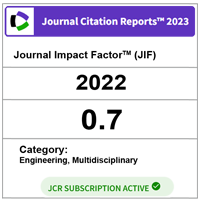Investigation of Future Building Performance Factors Towards Energy Efficient Travel Plan in Regional Developement
DOI:
https://doi.org/10.11113/jt.v70.3582Keywords:
Building performance factors, energy efficient travel plan, regional developmentAbstract
Preliminary research shows the shortcoming of Building Performance field of research to measure outdoor performance of building mainly EETP factors. Accordingly, this research aimed at proposing a future building performance towards Energy Efficient Travel Plan (EETP) based on user friendly EETP factors. The research methodology engaged three research phases. Phase 1 was to identify user friendly EETP factors. In this phase after a literature review, fix-format self reporting interview survey was conducted among experts in Travel Plan implementation in Malaysia. ‘Phase II’ was to investigate effective Building performance factors on user friendly EETP, within the literature review conducted on building performances followed by brainstorming with 5 experts in building management field of research. Final phase was to validate the proposed building performance towards EETP in a futuristic cross-impact scenario study. In summary, this research introduced three main outcomes, first: a list of user friendly EETP factors, second: EETP building performance factors and Third: future building performance factors towards EETP based on futuristic cross-impact analysis. In conclusion, this study introduced lists of new innovative future building performances including; BCS (Building Communication System), BEEM (Building Energy Education Management), EETP (Energy Efficient Travel Plan), BRc.S (Building Recycling System), and BAgr. (Building Agriculture) investigated as future building performance factors.
References
M. Enoch, S Ison. 2008. Expert Perspectives on the Past, Present and Future of Travel Plans in the UK, Research Report to the Department for Transport and the National Business Travel Network, Loughborough’s Institutional Repository, access at (https://dspace.lboro.ac.uk/).
D. Wake, A. Thom, R. Cummings. 2010. Evaluating workplace travel plans, Australasian Transport Research Forum, Proceedings 29 September–1 October 2010, Canberra, Australia Publication website: http://www.patrec.org.atrf.aspx.
T. Rye. 2011. Travel Plan: Do They work? Transport Policy Vol. 9 (2002) pp. 287. Bureau (EIB), report, /www.eib.org.my/index.php, access in April 2013.
S. Tyler, M. Enoch, L. Zhang. 2006. Setting up Local Travel Plan Groups: The Future of Workplace Travel Planning in Urban Conurbations? Examples from London, UK. Loughborough’s Institutional Repository, access at (https://dspace.lboro.ac.uk/).
H. B. Lamit, A. Shafaghat, M. Z. Majid, A. Keyvanfar, M. H. B. Ahmad, T. A. Malik. The Path Walkability Index (PAWDEX) Model: To Measure Built Environment Variables Influencing Residents' Walking Behavior. Advanced Science Letters. 19(10): 3017–3020.
A. Keyvanfar, A. Shafaghat, M. Z. Abd Majid, H. B. Lamit, M.W. Hussin, Kh. N. Binti Ali., A. Dhafer Saad. 2014. User Satisfaction Adaptive Behaviors for Assessing Energy Efï¬cient Building Indoor Cooling and Lighting Environment. Renewable and Sustainable Energy Reviews. 39: 277–295.
H. B. Lamit, A. Shafaghat, M. Z. Abd. Majid, A. Keyvanfar, Mohd Hamdan Bin Ahmad, T. A. Malik, R. B. Zin, M. Yadollahi. Application of the Path Walkability Index (Pawdex) Model: A Case Study of Retail Walking Pattern Recognition in Taman University Skudai, Johor, Malaysia. Advanced Science Letters. 19(10): 3021–3024.
N. Dorasol, I. Sarrazin Mohammad, A. H. Hakim Mohammed, N. Hamadan, N. M. Iezuan Nik Lah. 2012. Post Occupancy Evaluation Performance Criteria and Parameters for Hospital Building in Malaysia. Proceedings of 3rd ICBER 2012, 12–13 March 2012. ISBN:978-967-5705-05-2.
R. A. Dias., C. R., Mattos Balestieri. 2006. The Limits of Human Development and the Use of Energy and Natural Resources. Energy Policy. 34 (9): 1026–1031.
MS 1525:2007 Code of Practice on Energy Efficiency and the Use of Renewable Energy for Non-Residential Buildings.
ISO/TS 21931-1. 2006. Sustainability in Building Construction–Framework for Methods of Assessment for Environmental Performance of Construction works –Part 1: Buildings. http://www.iso.org/iso/catalogue_detail.htm?csnumber=40434.
M. Z. Abd Majid, W. Z. Zakaria, H. Lamit, A. Keyvanfar, A. Shafaghat; E. S. Bakti. 2012. Construction Information Systems for Executive Management in Monitoring Work Progress. Advanced Science Letters.  15(1): 169–171.
A. Keyvanfar, M. Z. Abd Majid, A. Shafaghat, H. Lamit, A. Talaiekhozan, M. W. Hussin, C. T. Lee, R. Mohamad Zin, M. A. Fulazzaky. Application of a Grounded Group Decision-making (GGDM) Model: A Case of Micro-organism Optimal Inoculation Method in Biological Self-healing Concrete. Desalination and Water Treatment. 52(19): 3594–3599.
H. Lamit, A. Shafaghat, M. Z. Abd. Majid, A. Keyvanfar, A. Shafaghat, Mohd Hamdan Bin Ahmad, and T. A. Malik. 2013. Grounded Group Decision Making (GGDM) Model. Journal of Advanced Science Letters. 19(10): 3077–3080.
Y. H. Lee, Ch.S Tan., Sh. Mohammad, M. M. D. Tahir, P. N. Shek. 2014. Review on Cold-Formed Steel Connections. The Scientiï¬c World Journal. 11–19.
E. Talebi, M. M. D. Tahir, F. Zahmatkesh, A. Yasreen, J. Mirza. 2014. Thermal Behavior of Cylindrical Buckling Restrained Braces at Elevated Temperatures. The Scientific World Journal. 
A. B. H. Kueh, W. W. She, P. N. Shek, C. S. Tan, M. M. Tahir. 2011. Maximum Local Thermal Effects Carpet Plot for Symmetric Laminated Composite Plates. Advanced Materials Research.  250–253: 3748–3751.
Downloads
Published
Issue
Section
License
Copyright of articles that appear in Jurnal Teknologi belongs exclusively to Penerbit Universiti Teknologi Malaysia (Penerbit UTM Press). This copyright covers the rights to reproduce the article, including reprints, electronic reproductions, or any other reproductions of similar nature.





